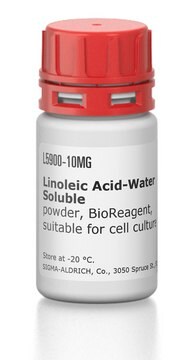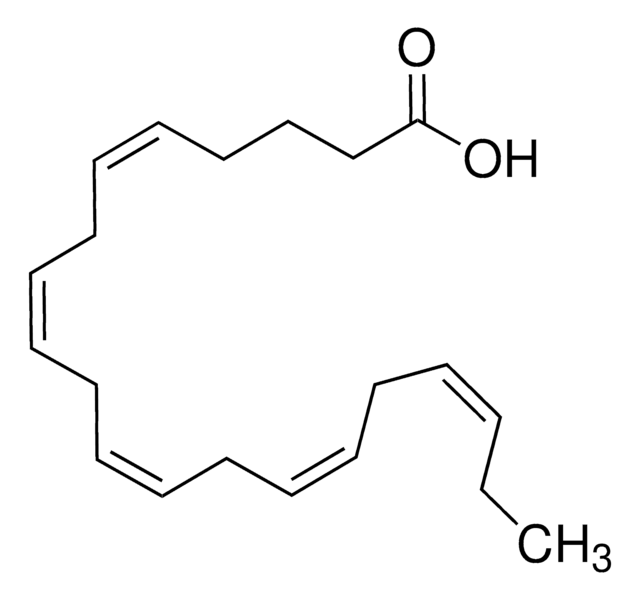L2376
Linolenic acid
≥99%
Synonim(y):
α-Lnn, cis,cis,cis-9,12,15-Octadecatrienoic acid
About This Item
Polecane produkty
Próba
≥99%
współczynnik refrakcji
n20/D 1.480 (lit.)
tw
230-232 °C/1 mmHg (lit.)
mp
-11 °C (lit.)
gęstość
0.914 g/mL at 25 °C (lit.)
typ lipidu
omega FAs
temp. przechowywania
−20°C
ciąg SMILES
CC/C=C\C/C=C\C/C=C\CCCCCCCC(O)=O
InChI
1S/C18H30O2/c1-2-3-4-5-6-7-8-9-10-11-12-13-14-15-16-17-18(19)20/h3-4,6-7,9-10H,2,5,8,11-17H2,1H3,(H,19,20)/b4-3-,7-6-,10-9-
Klucz InChI
DTOSIQBPPRVQHS-PDBXOOCHSA-N
Szukasz podobnych produktów? Odwiedź Przewodnik dotyczący porównywania produktów
Opis ogólny
Zastosowanie
- to assess the total antioxidative activity of serum and bacteria
- in palleroni chamber assay
- to prepare free fatty acid mixture
Działania biochem./fizjol.
Opakowanie
Kod klasy składowania
10 - Combustible liquids
Klasa zagrożenia wodnego (WGK)
WGK 1
Temperatura zapłonu (°F)
235.4 °F - closed cup
Temperatura zapłonu (°C)
113 °C - closed cup
Środki ochrony indywidualnej
Eyeshields, Gloves
Certyfikaty analizy (CoA)
Poszukaj Certyfikaty analizy (CoA), wpisując numer partii/serii produktów. Numery serii i partii można znaleźć na etykiecie produktu po słowach „seria” lub „partia”.
Masz już ten produkt?
Dokumenty związane z niedawno zakupionymi produktami zostały zamieszczone w Bibliotece dokumentów.
Klienci oglądali również te produkty
Produkty
Importance and uses of linolenic acid in serum-free eukaryotic, including hybridoma and Chinese Hamster Ovary (CHO) cell, cultures
AEM3-944 | UAT | Prefill feature for related product categories not working
The potential for the prevention and treatment of cardiovascular disease through increased dietary intake of omega-3 (w-3) fish oils is not a recent scientific discovery.
Lipid Induced Insulin Resistance
Nasz zespół naukowców ma doświadczenie we wszystkich obszarach badań, w tym w naukach przyrodniczych, materiałoznawstwie, syntezie chemicznej, chromatografii, analityce i wielu innych dziedzinach.
Skontaktuj się z zespołem ds. pomocy technicznej





